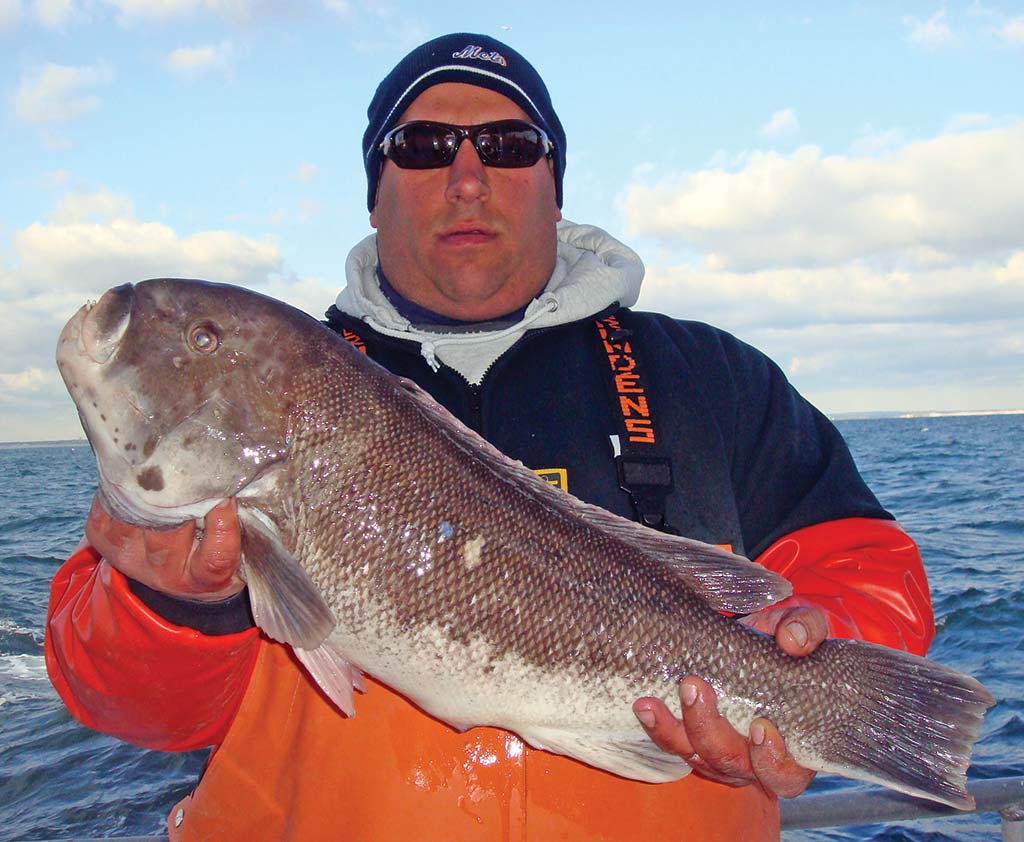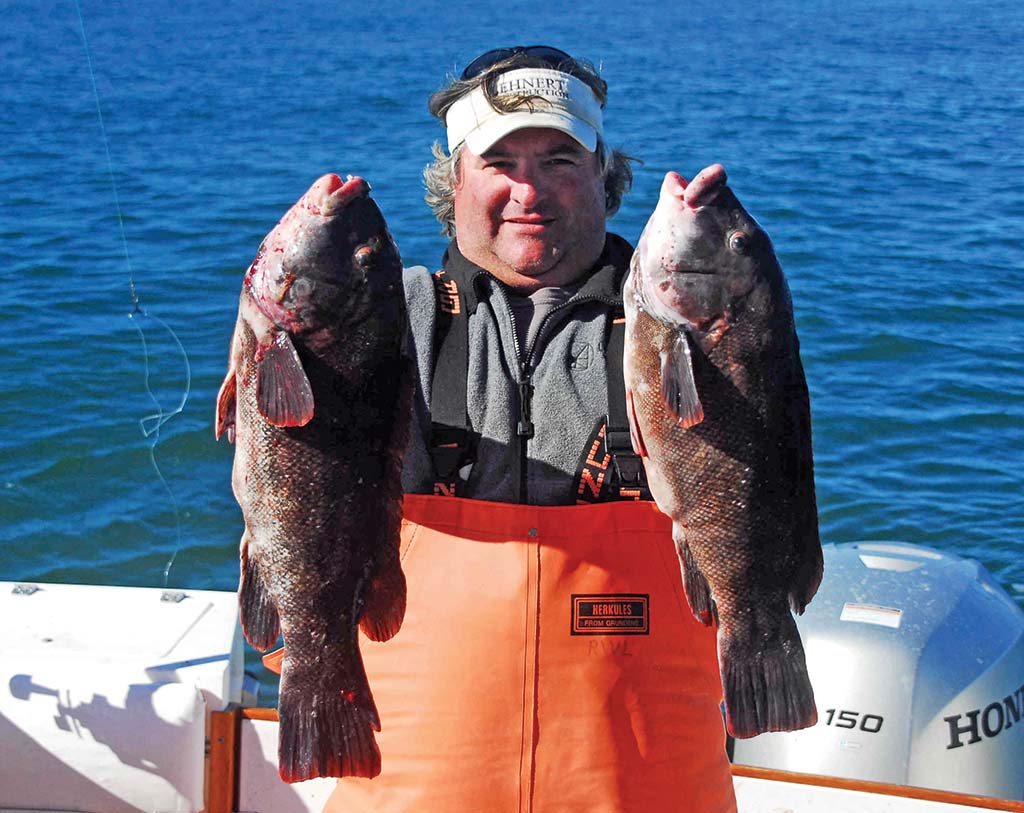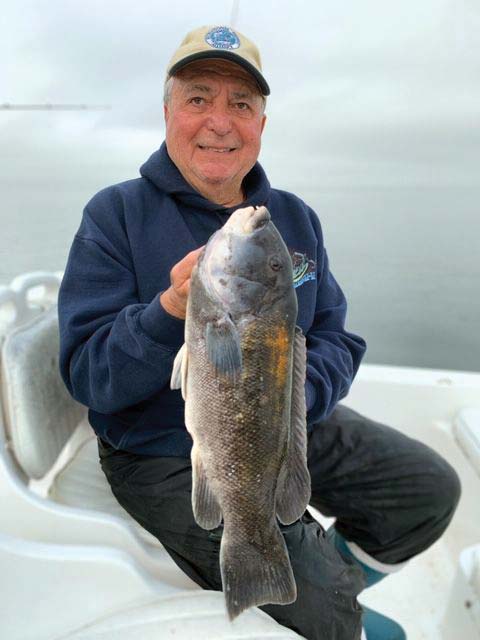
November can be a desirable and pleasant month to fish for blackfish.
Come November, the Long Island south shore artificial reefs begin to come alive to the delight of blackfish anglers. Chilling water temperatures send most of the summer and early fall bottom dwellers packing for the deeper, warmer offshore waters, while togs ranging from rats to slobs settle in for the next month and a half, feeding and fattening up for their winter hibernation. Tog anglers realize time is of the essence and that countless double-digit slob tog will be posing for the cameras, while Fisherman subscribers gain a chance to win a 255 Center Console Steiger Dream Boat. If you happen to be a subscriber and plan on some tog fishing this month, you’ve opened up to the right feature filled with the correct details to make that dream possible.
Tough And Toothy
Blackfish are a structure-orientated species that spend most of their days feeding on crustaceans burrowed in among rocks, sunken ships, and natural or artificial reefs year-round along both shores of Long Island. Blackfish will head for deeper, cooler waters during the summer, but rarely will you find them exceeding 150-feet in depth. During the winter, they will hibernate in their deep comfortable lairs until the warm days of spring send them into shallow sandy bottom to spawn before heading back deep.
Wisely, DEC had shut down the spring fishery several years ago to allow the females to lay their eggs with minimal pressure by fishermen. As the fishery built back strongly, the New York State waters were reopened.
A Place Called Home
Since fishing wrecks and rockpiles can become quite crowded during tog season, artificial reefs have long been constructed to enhance recreational fishing and sport diving opportunities to local inshore and offshore waters. From Shinnecock to the Highlands of New Jersey, the reefs consist of suitable long-lived, stable, and environmentally safe materials placed on areas just south of all the significant inlets that were once barren of sea life. Once the materials were sent to their final resting place, it wasn’t long that the structure favoring bottom dwellers inhabited the reefs seeking shelter from predatory species.
Eventually, about every inch of these manufactured wonderlands became colonized by mollusks, barnacles, and crustaceans, which draws a community of gamesters and bottom dwellers alike—especially togs. Since winter storms and hurricanes often cause some of the lower-lying structure to become buried in sand or silt, DEC will often add cleaned up material of donated boats, barges, pipes, and just recently much of the old and broken up Tappan Zee Bridge which was distributed over each of the reefs along the south shore including the Twelve Mile Reef south of Moriches Inlet.

Toys Make The Most Noise
To find the proper structure at any reefs you plan to fish, having the appropriate electronics onboard is paramount. Start with a quality bottom recorder since it will paint the picture of the structure that lies below. Once a good piece has been found, you will need to mark it with a GPS by hitting the MOB button.
Used properly, you can use the GPS to find where to set the anchor and how much scope you will need to sit over your desired position. Should using a GPS be a bit challenging or unavailable, the traditional way of tossing a marker buoy over and anchoring around it will always make for a desirable alternative. Having a marker buoy sitting on the piece of wreck also gives a better feel of anchoring. It comes down to preference as some anglers would instead go to the marker, while most anglers work directly from their electronics.
Bright yellow painted bleach bottles filled with water-resistant insulation foam for added buoyancy are best suited for the task. Be sure to spool enough nylon twine and attached it to two double-weighted window sash weights to hit the bottom without becoming submerged beyond reach or floating away. Make sure to have a couple of backup markers and weights since there are times when the markers become entangled in the spool of twine.
Anchors Away
Anchoring for blackfish on any artificial reef is always relevant. Anchors must have an ample chain between 8- and 12-feet in length. The longer the chain, the quicker the anchor sets. Therefore if you plan to fish the deep-water swift current spots such as the Shinnecock or Twelve Mile Reefs, a 12-foot chain will suit adequately. Keep in mind that the productive depth will vary between 60 and 85 feet; therefore, ensure you have enough anchor rope to manage these depths. Since there is always the possibility of the anchor getting wedged in between a sticky piece of structure, you should always have a backup plan with at least another anchor, chain, and rope.
If seas are flat calm, you may want to alternate to a wreck anchor. The beauty of these bendable grappling hooks is anchoring right onto the wreck, and when it comes time to yank it free, you can use the motor power of the boat to pull it free, then bend the rebar back into shape. Regardless of what type of anchor you’re employing, resorting to an anchor ball will make life a lot easier, especially during the new or full moon when lifting the anchor becomes a tough job.
Rigs And Jigs
In my boyhood days, the concept was always to keep the bait still if you wanted to catch big blackfish. Yet, the more I learned about this marvelous species, I found nothing could be further from the truth. I’ve found that at times jigging as if you were flounder fishing or a slow uplift of the rod was the only way of icing a limit of togs.
Rockaway Reef
40.32.730 73.51.210
40.32.200 73.51.210
Atlantic Beach Reef
40.32.020 73.43.700
40.31.530 73.43.700
Hempstead Reef
40.31.250 73.33.350
40.30.670 73.33.520
Fire Island Reef
40.36.100 73.13.500
40.35.600 73.13.500
Moriches Reef
40.43.470 72.46.640
40.43.400 72.46.620
Twelve Mile Reef
40.37.250 72.32.250
40.36.250 72.30.930
Shinnecock Reef
40.48.160 72.28.670
40.48.040 72.28.700
Tog fishing has come a long way from my time as a kid. Exchanging a blackfish rig baited with either a fiddler or green crab to posh colored lead head jigs from a half to 10 ounces has been the craze; whether fishing for tautog in shallow or deep water, in mild currents, or swift-moving tidal waters. While blackfish jigs are effective at all the south shore reefs, they are a bit too pricy for the amount of them that succumb to the merciless sticky burrows that prominent white chins settle on. Naturally, the choice is yours, so if the pocketbook allows, jigs fished with hard baits will produce very well; otherwise, the standard and Snafu rig will not disappoint.
Standard rigs best suited at the reefs consist of a Gamakatsu 3/0 Octopus hook connected to a dropper loop on an 8-foot length of 40-pound fluorocarbon leader placed 4 to 6 inches above the sinker. These hooks are super sharp, strong, short shank, and are easy to bury crab baits without the concerns of a tog dropping the bait. Many anglers still prefer the number 3,4, or 5 Virginia hooks, which work well, but their points are often dull when coming out of the box, which if not sharpened before using, you may suffer a lot of swings and misses.
Keep the rigs to a single hook. It’s much easier to deal with one hook than two, especially when the big females are around. Besides, there will be far fewer hang-ups and spin. Many savvy tog fishermen employ snafu rigs which consist of twin snelled hooks joined together using an Albright Knot. This rig comes to play when fishing whole live crabs hooked on both sides behind the claws. I usually tie several of these rigs before the start of the season using the super sharp 3/0 Gamakatsu Octopus hooks. I also like Mustad’s 2/0 Big Gun hooks which work well when togs play hard to get.
Sinkers round out the terminal end—bring along a good assortment of bank sinkers between 4 and 12 ounces, as well as plenty of extra hooks and fluorocarbon leader since you may meet several snags that won’t play nice. Finally, if you find you’re donating several rigs, keep in mind the stickiest pieces of obstruction often produce the largest blackfish. Therefore stay optimistic and stick at it. The dividends may come as a 25-foot Steiger Craft for some.
Brunch Is Being Served

While the blackfish menu can be pretty selective this day and age, water temperatures and location are more of a factor when it comes to munching out on their favorite crustacean. It’s relevant to note that the colder the seawater is to 53 degrees, the harder the bait should be.
Since water temperatures during November will range between 55 and 58 degrees, white, hermit, and green crabs will be most preferred by the togs. Fiddler, Asian, and calico crabs will undoubtedly catch the smaller rats that are often abundant at all the reefs, which can be a nuisance when trying to get to the big white chins. Small white leggers, better known as white or stone crab, fished whole undoubtedly catch double-digit slob togs, while whole medium-sized hermit crabs come in at a close second as a favorite. Green crabs are most commonly employed due to easy access and the cost being far less than a bushel of hermits and white crabs.
I’ve had days when green crabs weren’t touched while I was slaying togs on white and hermits. Then again, I’ve had days when all they wanted was the greenies. Therefore if you take your togging seriously and want to tangle with true bulldogs, spend the extra few bucks and pick up a half bushel of hermits and half a bushel of whites. Both baits work best whole but when impaling the whites to the hook, make sure to crack the shell just a bit to get the juices flowing, enticing their appetite and get them chewing.
Breakers Can Break You
November can be a desirable and pleasant month to fish for blackfish with moderate air temperatures, calm seas, and good fishing. However, each south shore inlet shares the same concern—clearing the breakers that often greets boaters as they approach the head of an inlet.
This wall of white water may not look too challenging until you meet it head-on. Take it from me with 40 years of experience of piloting through all kinds of conditions at Moriches Inlet. Many mornings exiting the inlet was just a matter of timing the swells until we cleared the shoal, and seas would flatten out. However, many afternoons saw just the opposite conditions. Unless you are experienced in navigating through challenging seas and treacherous breakers, it would be best to head for a head boat or save the trip for another day.
Please don’t be misled; most days, getting through the inlet will not be a problem; however, safety first as white water is no joke. Make sure to check the marine forecast, sea condition, and the time of slack tide. The safest time to cruise the head of an inlet is during slack tide since the breakers are settled and the seas are at their flattest. Days when winds are less than 15 knots are desirable—mainly when the winds are from the north or northwest. Fortunately, the run back to all the inlets from any of the reefs is quick, and with some intelligent thinking and preplanning, you should be back at the dock and home for that well-deserved tasty blackfish dinner.



